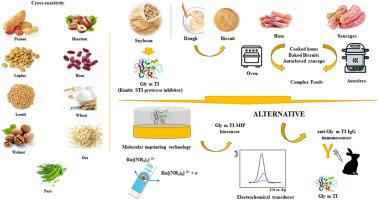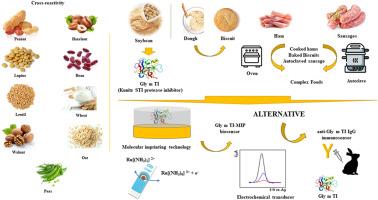用于复杂食品中大豆过敏原定量的原位电化学合成 "人工 "Gly m TI 抗体
IF 6
2区 化学
Q1 CHEMISTRY, ANALYTICAL
引用次数: 0
摘要
生物传感器,尤其是用于检测大豆中的 Gly m TI 等食物过敏原的生物传感器,在保护食物过敏患者方面发挥着至关重要的作用,不仅关系到个人健康,还关系到更广泛的公共卫生问题。此外,将它们集成到食品生产和监测流程中有助于遵守监管标准,减少与过敏原有关的召回事件,保护弱势群体。生物传感器开发技术的进步,例如便携性的提高、实时监测能力的增强以及用户友好的界面,扩大了生物传感器的实际应用范围,使其在各种环境中都不可或缺,包括制造工厂、食品服务机构,甚至消费者在家中使用。Gly m TI-MIP 经过了全面的验证过程,使用的是对胰蛋白酶抑制剂产生多克隆反应的抗 Gly m TI IgG。Gly m TI-MIP 成功地在一系列食品基质中进行了测试,包括树坚果(如花生、核桃和榛子)和豆类(如扁豆、豆类和羽扇豆),与羽扇豆和核桃的交叉反应极小。该创新方法在 1 ag mL-1 - 10 μg mL-1 范围内提供线性响应,LOD<1 ag mL-1。将 Gly m TI-MIP 传感器应用到复杂的模型食品中,可以检测出饼干、火腿和香肠在各自热处理前后的大豆分离蛋白含量为 0.1 mg kg-1(0.00001%)。这种创新型生物传感器可以解决加工食品和未加工食品中过敏原追踪的复杂问题,从而大大改善食品安全协议。通过确保严格的过敏原控制,这些生物传感器可以支持全球食品贸易遵守国际安全标准,增强消费者信心,提高食品标签的透明度,最终促进食品供应链的安全。本文章由计算机程序翻译,如有差异,请以英文原文为准。


In-situ electrochemically synthesized “artificial” Gly m TI antibody for soybean allergen quantification in complex foods
Biosensors, especially those designed for detecting food allergens like Gly m TI in soybean, play a crucial role in safeguarding individuals who suffer from adverse food allergies, extending to both individual well-being and broader public health considerations. Furthermore, their integration into food production and monitoring processes aids in compliance with regulatory standards, reducing the incidence of allergen-related recalls and protecting vulnerable populations. Technological advancements in biosensor development, such as increased portability, real-time monitoring capabilities, and user-friendly interfaces, have expanded their practical applications, making them indispensable in various settings, including manufacturing plants, food service establishments, and even at-home use by consumers.
For the first time, a biosensor targeting the Gly m TI allergen based on molecularly imprinted polymer (MIP) technology was developed to detect/quantify soybean in complex food matrices and effectively address the detection challenges of complex and processed foods. The Gly m TI-MIP underwent a thorough validation process using anti-Gly m TI IgG raised as a polyclonal response to the trypsin inhibitor. Gly m TI-MIP was successfully tested across a range of food matrices, including tree nuts (e.g., peanuts, walnuts, and hazelnuts) and legumes (e.g., lentils, beans, and lupine), presenting minimal cross-reactivity with lupine and walnut. The innovative approach provided a linear response in the 1 ag mL−1 - 10 μg mL−1 range, with a LOD<1 ag mL−1. Applying the Gly m TI-MIP sensor to complex model foods allowed to detect 0.1 mg kg−1 (0.00001 %) of soybean protein isolate in biscuits, ham, and sausages before and after the respective thermal treatments. The innovative biosensor can significantly improve food safety protocols by addressing the complexities of tracing allergens in processed and unprocessed food products. By ensuring rigorous allergen control, these biosensors may support global food trade compliance with international safety standards, boost consumer confidence, and promote transparency in food labeling, ultimately contributing to a safer food supply chain.
求助全文
通过发布文献求助,成功后即可免费获取论文全文。
去求助
来源期刊

Analytica Chimica Acta
化学-分析化学
CiteScore
10.40
自引率
6.50%
发文量
1081
审稿时长
38 days
期刊介绍:
Analytica Chimica Acta has an open access mirror journal Analytica Chimica Acta: X, sharing the same aims and scope, editorial team, submission system and rigorous peer review.
Analytica Chimica Acta provides a forum for the rapid publication of original research, and critical, comprehensive reviews dealing with all aspects of fundamental and applied modern analytical chemistry. The journal welcomes the submission of research papers which report studies concerning the development of new and significant analytical methodologies. In determining the suitability of submitted articles for publication, particular scrutiny will be placed on the degree of novelty and impact of the research and the extent to which it adds to the existing body of knowledge in analytical chemistry.
 求助内容:
求助内容: 应助结果提醒方式:
应助结果提醒方式:


